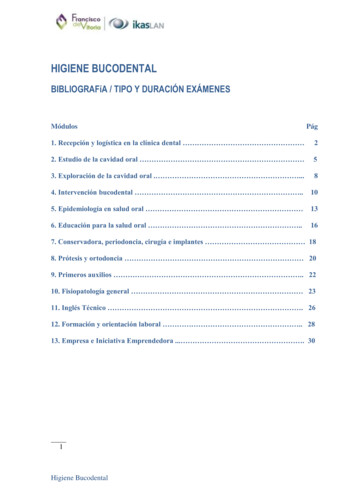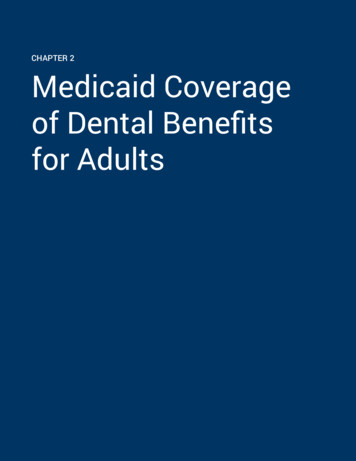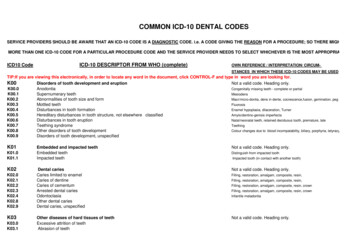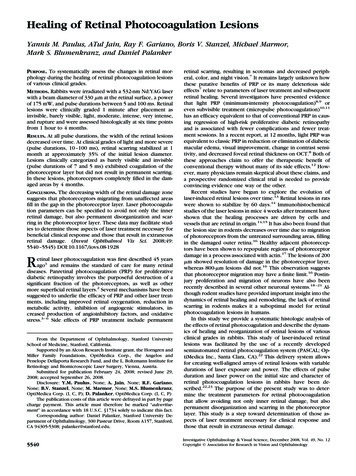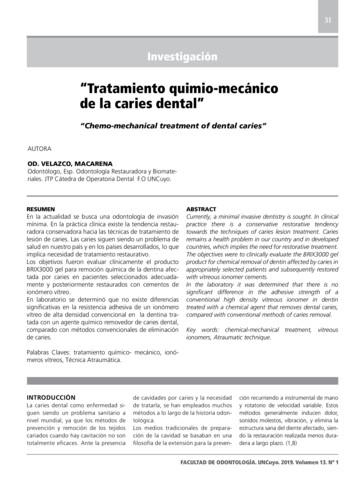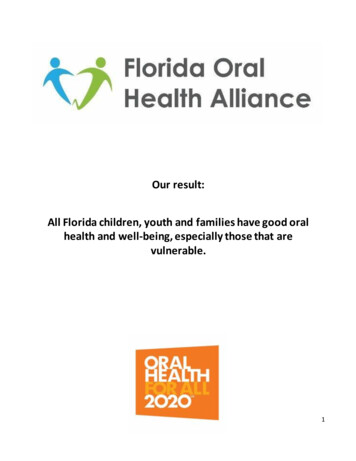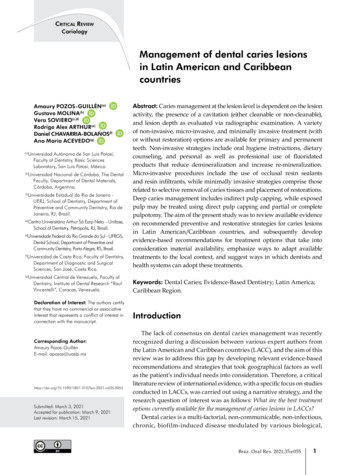
Transcription
CritiCal reviewCariologyManagement of dental caries lesionsin Latin American and CaribbeancountriesAmaury POZOS-GUILLÉN(a)Gustavo MOLINA(b)Vera SOVIERO(c,d)Rodrigo Alex ARTHUR(e)Daniel CHAVARRIA-BOLAÑOS(f)Ana María ACEVEDO(g)(a)Universidad Autónoma de San Luis Potosí,Faculty of Dentistry, Basic SciencesLaboratory, San Luis Potosí, México.(b)Universidad Nacional de Córdoba, The DentalFaculty, Department of Dental Materials,Córdoba, Argentina.(c)Universidade Estadual do Rio de Janeiro UERJ, School of Dentistry, Department ofPreventive and Community Dentistry, Rio deJaneiro, RJ, Brazil.(d)Centro Universitário Arthur Sá Earp Neto – Unifase,School of Dentistry, Petrópolis, RJ, Brazil.(e)Universidade Federal do Rio Grande do Sul - UFRGS,Dental School, Department of Preventive andCommunity Dentistry, Porto Alegre, RS, Brazil.(f)Universidad de Costa Rica, Faculty of Dentistry,Department of Diagnostic and SurgicalSciences, San José, Costa Rica.Abstract: Caries management at the lesion level is dependent on the lesionactivity, the presence of a cavitation (either cleanable or non-cleanable),and lesion depth as evaluated via radiographic examination. A varietyof non-invasive, micro-invasive, and minimally invasive treatment (withor without restoration) options are available for primary and permanentteeth. Non-invasive strategies include oral hygiene instructions, dietarycounseling, and personal as well as professional use of fluoridatedproducts that reduce demineralization and increase re-mineralization.Micro-invasive procedures include the use of occlusal resin sealantsand resin infiltrants, while minimally invasive strategies comprise thoserelated to selective removal of caries tissues and placement of restorations.Deep caries management includes indirect pulp capping, while exposedpulp may be treated using direct pulp capping and partial or completepulpotomy. The aim of the present study was to review available evidenceon recommended preventive and restorative strategies for caries lesionsin Latin American/Caribbean countries, and subsequently developevidence-based recommendations for treatment options that take intoconsideration material availability, emphasize ways to adapt availabletreatments to the local context, and suggest ways in which dentists andhealth systems can adopt these treatments.(g)Universidad Central de Venezuela, Faculty ofDentistry, Institute of Dental Research “RaulVincentelli”, Caracas, Venezuela.Declaration of Interest: The authors certifythat they have no commercial or associativeinterest that represents a conflict of interest inconnection with the manuscript.Corresponding Author:Amaury Pozos-GuillénE-mail: r-2021.vol35.0055Submitted: March 3, 2021Accepted for publication: March 9, 2021Last revision: March 15, 2021Keywords: Dental Caries; Evidence-Based Dentistry; Latin America;Caribbean Region.IntroductionThe lack of consensus on dental caries management was recentlyrecognized during a discussion between various expert authors fromthe Latin American and Caribbean countries (LACC), and the aim of thisreview was to address this gap by developing relevant evidence-basedrecommendations and strategies that took geographical factors as wellas the patient’s individual needs into consideration. Therefore, a criticalliterature review of international evidence, with a specific focus on studiesconducted in LACCs, was carried out using a narrative strategy, and theresearch question of interest was as follows: What are the best treatmentoptions currently available for the management of caries lesions in LACCs?Dental caries is a multi-factorial, non-communicable, non-infectious,chronic, biofilm-induced disease modulated by various biological,Braz. Oral Res. 2021;35:e0551
Management of dental caries lesions in Latin American and Caribbean countriesbehavioral, psychosocial, and environmentalfactors.1 Caries lesions are typically characterizedby the active loss of tooth minerals, induced bythe metabolic activity of dental biofilm formedby frequent consumption of a sugar-rich diet. In theabsence of any intervention, the cumulative effects ofalternating demineralization and re-mineralizationcycles (favoring the former) leads to the developmentof a clinically visible lesion,2,3 and defensive reactionssuch as increased intra-tubular dentin formation andinitial pulpitis may occur in the dentin-pulp complexupon lesion progression.4 When left untreated, carieslesions may slowly progress into the deep dentin andpulpal tissue and, in severe cases, profoundly affectthe general health and decrease the quality of lifeof the patients.5 Severe caries lesions represent theprimary cause of oral pain and tooth loss globally.6Despite significant advances in oral-health sciences,the World Health Organization have highlighted thehigh prevalence of dental caries in various developingcountries and particularly those in the LACC regionwhere caries represent a major unmet need of thepopulation. 7 Numerous studies have reportedprevalence rates of 40% to 90% among children,teenagers, and adults in this geographic region,8 andthe management of dental caries is often beyond thefinancial capabilities of low-income countries wherelimited resources hinder access to high-quality dentaltreatments.9 Therefore, better use of financial resourcesthrough the development of evidence-based protocolsrecommending non-invasive or minimally invasiverestorative treatments is essential.Dental caries need to be managed at the patient andlesion levels. Patient-level interventions include noninvasive strategies that aim to control disease progressionand lesions becoming clinically detectable. This can beachieved through dietary counseling and comprehensiveoral hygiene measures such as mechanical removal ofthe dental biofilm through daily tooth-brushing usingfluoridated dentifrices which promote re-mineralizationby re-establishing the mineral balance between the toothsurface and the surrounding aqueous phase (representedby the saliva and dental biofilm fluid).2 However, thesuccess of these interventions is directly dependenton patient adherence to the treatment protocol, andit has been suggested that the best practice for dental2Braz. Oral Res. 2021;35:e055caries management should include a more patientcentered model consisting of individualized caries riskassessment and early detection of non-cavitated carieslesions. This approach aims to achieve personalizedtreatment for the individual patient, and focuses onthe treatment and prevention of dental caries at thepatient level.10Dental caries management at the lesion level includesa wide range of non-invasive, micro-invasive, andminimally invasive interventions that vary dependingon the lesion activity, presence of cavitation (cleanableor non-cleanable), and lesion depth (shallow/moderate/deep - evaluated using radiographic examination).3These interventions aim to arrest lesion progression,preserve pulpal health by creating a hermetic seal againstmicrobial invasion (through placement of a restoration),and re-establish the tooth’s structure and function foras long as possible.11 The management protocol for deepcaries lesions with a high risk of pulp exposure shouldinclude selective removal of caries tissues followedby the placement of new and improved pulp cappingbiomaterials if necessary.12 This contemporary approachto management of caries lesions results in less expensiveand more predictable outcomes from the histologicaland clinical points of view.4Therefore, this review aims to describe currentstrategies for the management of dental caries at thelesion level for primary and permanent dentition, andmake evidence-based recommendations targetingdental practitioners in LACCs.Strategies for the management of carieslesions: Scientific evidence from LACCsA direct comparison of studies was hindered by thelack of consensus on the management of caries lesions andvariations in methodologies and study designs adopted.Therefore, prior to commencement of the evidence-basedreview, the authors first defined the primary objective bymeans of a set of questions focusing on the managementof all caries lesions (ranging from non-cavitated lesions todeep cavities) while taking socioeconomic and culturalfactors of LACCs into consideration.Based on evidence from various clinical trials (someof which were conducted in LACCs), practitionersand health policy-makers should adopt cariesmanagement strategies that take the depth of the
Pozos-Guillén A, Molina G, Soviero V, Arthur RA, Chavarria-Bolaños D, Acevedo AMlesion into consideration as these techniques tendedto be cost-effective and could, therefore, be adoptedby conventional public dental health service inLACCs. This would be particularly beneficial forthe enhancement of oral-health care in deprivedcommunities by increasing accessibility to preventiveand restorative treatments. Some of the strategies forcaries lesion management have been presented below.Selection of an appropriate strategy should beginwith a careful and precise diagnosis at the lesionlevel. Inactive lesions are typically characterizedby the presence of shiny whitish/brownish areasof discoloration on non-cavitated lesions as wellas of shiny, smooth, hard on gently probing, anddiscolored brownish in cavitated lesions reachingdentin. These lesions typically do not require anyintervention other than monitoring as they are diseasescars, although restorations can be placed in cavitatedlesions in order to protect the pulp-dentin complexor restore the tooth’s function, form, and esthetics.13Conversely, opaque, rough and whitish tissueon non-cavitated lesions and the presence of soft orleathery (to gently probing) humid and yellowish/light-brownish tissue in cavitated lesion reachingdentin are clinical signs of active lesions that need tobe controlled. Clinicians must be trained to identifyearly signs of active demineralization which willenable them to intervene in a timely manner using noninvasive and micro-invasive strategies. For cavitatedlesions, it is essential to first take into considerationwhether the cavity can be cleaned or not as it willhelp with the decision-making process and selectionof the best treatment strategy. Non-invasive strategiesare sufficient for the management of cavities thatcan be cleaned, while those that cannot be cleanedmay require a combination of non-invasive, microinvasive, or minimally invasive strategies coupled withrestorations. This decision-making process should bebiologically informed, evidence-based, and shouldtake the needs of the patient into consideration.Management of non-cavitated lesions—Non-invasive/micro-invasive strategiesThe primary prevention of dental caries typicallyinvolves inhibition of lesion initiation as indicatedby the recent consensus on the term dental cariescare/management/control as “all actions taken tointerfere with mineral loss at all stages of the diseaseprocess” This includes primary, secondary, andtertiary preventive measures that incorporate bothnon-operative and operative treatments.1Disease triggering factors must be controlled inorder to prevent formation of caries lesions and arrestprogression of existing ones. Therefore, preventivestrategies should take biological, behavioral,psychosocial, and environmental factors intoconsideration in order to avoid negatively affectingthe oral environment.14 Oral hygiene measures, dietarycounseling, and other non-invasive strategies (such asthe application of fluoride and chlorhexidine varnishesand the use of xylitol lozenges) have been shown to beeffective in controlling active non-cavitated lesions inchildren.15 Some of these strategies will be reviewedin the subsequent section to highlight the need forsimultaneous management of the disease and lesion.Various experimental and clinical studies havedemonstrated that caries lesions originate in the enamelor exposed root dentine beneath accumulated andstagnated dental biofilms. The dental caries processinitiation and progression depend on the metabolicactivity of the dental biofilm which, in turn, is enhancedby frequent intake of dietary sugars. Therefore, regularand meticulous mechanical removal of the dentalbiofilm aids in arresting lesion progression.16However, previous studies have shown that personaloral hygiene protocols (by means of supervisedtooth-brushing) lacking fluoride administration,either via dentifrices or community-based methods,were effective in controlling gingivitis but failed toprevent coronal caries in children aged 10-13 yearsold.17 This reinforces the importance of fluoridatedproducts (e.g. dentifrices) and/or community-basedmethods for fluoride delivery in lesion control.The selection of appropriate strategies for theprevention of lesion formation and inhibition ofdisease progression can be challenging for the dentalprofessional, and the decision-making process shouldbe based on scientific evidence focusing on whenand how to implement the strategy while taking theneeds of the patient and the availability of financialand technical resources, especially in public healthsystems, into consideration. Selection of multipleBraz. Oral Res. 2021;35:e0553
Management of dental caries lesions in Latin American and Caribbean countriesstrategies may be necessary, and the risk of cariesexhibited by the patient may even be considered onthe decision-making process.18The recent global decrease in the prevalence ofdental caries can be attributed to the widespread useof fluoride-containing dentifrices,19,20 with numerousclinical studies showing that mechanical removalof the dental biofilm by daily tooth-brushing usingfluoridated dentifrices in concentrations of 1,000–1,500 ppm F significantly contributed to controllingenamel, dentin, and/or root caries lesions. 20-23Moreover, tooth-brushing twice a day using fluoridedentifrices at concentrations of 5000 ppm F wasshown to be more effective in arresting root caries inthe elderly population compared to dentifrices withconcentrations of 1,000–1,500 ppm F.23,24 Professionaldental biofilm management should be also consideredas a treatment option for dental caries.In addition to dentifrices, a wide range of topicalfluoride-based agents are available for individual use,25including high-concentration fluoride products (suchas acidulated phosphate gels, varnishes and solutions)which allow deposition of greater amounts of calciumfluoride globules onto the tooth surface formingfluoride reservoirs in the oral cavity. Progression ofnon-cavitated caries lesion in primary and permanentteeth can be significantly controlled by 5% NaFvarnishes,26 while 38% silver diamine fluoride (SDF)represent a more effective strategy for the controlof cavitated caries lesions reaching dentine whencompared to other active treatments (e.g. atraumaticrestorative treatment (ART) restorations or NaFvarnish).27 SDF has also been shown to be effectivein inactivating root caries lesions.24,28,29A m o n g n o n -f luo r id at e d ag e nt s, c a s e i nphosphopeptide-amorphous calcium phosphate(CPP-ACP) is a bioactive agent that has been shownto be effective in re-mineralizing tooth structures invitro and in vivo. A recent meta-analysis suggestedthat CPP-ACP, conventional fluoride toothpastes, andfluoride varnishes had similar efficacy with regard tocontrolling lesion development, and clinical parameterssuch as enamel micro-hardness, DMFS/dmfs (decayed,missing, filled surfaces) index scores, and EnamelDecalcification Index scores did not differ significantlybetween CPP-ACP and fluoride products.30 Moreover, a4Braz. Oral Res. 2021;35:e055combination of CPP-ACP and fluoride varnish wasshown to have superior anti-caries effect, particularlyin enamel lesions on young permanent teeth, as CPPACP could carry fluoride ions deeper into the lesions,enhancing re-mineralization. Nevertheless, there isinsufficient evidence on whether CPP-ACP agentsare more effective in controlling caries lesions whencompared to fluorides, and high quality, well-designedrandomized controlled trials are necessary.30The cariostatic effects of non-fluoridated chemicalagents such as arginine, chlorhexidine, triclosan, andxylitol have been evaluated in vivo and comparedwith conventional fluoride in several randomizedcontrolled trials. A recent systematic review comparedthe efficacy of non-fluoridated agents and fluoridein controlling caries in primary teeth and found noevidence of the former being superior. However, thiscould be attributed to a high risk of bias in most studiesreviewed,31 and well-designed randomized controlledtrials are necessary in order to make conclusiverecommendations. Chlorhexidine varnish was foundto be more effective in controlling root caries lesionscompared to placebos, and the results were consistent.32An in vitro study examined the use of theobromine(3,7-dimethylxanthine), a primary alkaloid derivedfrom the cacao plant commonly found in LACCs, as are-mineralizing component of dentifrices and foundit to be less effective than those containing fluoride.33The use of nanotechnology to enhance the anticaries effects of dentifrices, varnishes, surface coatingagents, and fluoride-releasing materials have also shownpromising results, with the use of oral medicine nanosystems for individual prophylaxis showing significantprogress with regard to ensuring bacterial symbiosisand maintaining good oral health. Nano-particles havealso been integrated into various cosmetic productstargeting enamel re-mineralization, thus creatingopportunities for new research into the developmentof enhanced delivery systems that serve as carriersfor minerals and/or biomaterials. Their clinical use forcontrol of caries lesions remains under evaluation.34Current evidence also recommends the use of pitand fissure sealants as a micro-invasive strategy forthe prevention and control of caries lesions.24 Resinbased fissure sealants act as a physical barrier betweenthe tooth surface and the stagnated dental biofilm and
Pozos-Guillén A, Molina G, Soviero V, Arthur RA, Chavarria-Bolaños D, Acevedo AMsuccessfully reduce the onset and progression of occlusalcaries lesions, particularly in permanent molars.35This evaluation is largely based on evidence that showsthat sealing a lesion reduces the bioavailability ofnutrients to microbial growth, thus preventing diseaseprogression up to 70% in non-cavitated occlusal lesionswhen compared to no sealing.35,36 Moreover, sealants aremore effective in arresting active non-cavitated occlusallesions when compared to fluoride varnishes, althoughthere is still no clear evidence on the best sealant (resinbased or glass ionomer).37 However, the questionableintegrity and stability of sealants placed on occlusallesions that appear non-cavitated clinically but extendinto the middle or inner dentine radiographically shouldbe taken into consideration, and a minimally invasiverestorative strategy (as described below) should beadopted in such cases.13In contrast to sealants, resin infiltration acts as abarrier not on the tooth surface but within the carieslesion. Filling the enamel lesion, the resin can occludethe porosities, thus preventing the lesion progressionby avoiding the penetration of the acids originatedin the dental biofilm located on the external toothsurface. Previous studies have shown that resininfiltration is more effective in controlling non-cavitatedproximal caries when compared to other non-invasiveapproaches, both in primary and permanent teeth.38,39Management of cavitated dentine lesionsAs mentioned above, the decision-makingprocess for the management of active cavitatedlesions is dependent on whether the cavity can becleaned (where mechanical biofilm removal canbe carried out at home by tooth-brushing) or not.The former can be managed non-invasively, and itis assumed that the disease process is halted andlesion progression is arrested upon adequate removalof the biofilm. Accessibility for adequate cleaningcan be increased by slightly widening the cavitymargins to remove overhanging enamel/dentine.40However, patient motivation is crucial in this case, andregular monitoring for proper mechanical removalof biofilm is essential. This is particularly applicablein the case of primary dentition where the child’soral hygiene is the responsibility of their parents orcaretakers who must also be adequately informed andmotivated. Periodic clinical examination is necessaryfor assessment of lesion activity, and treatment successis achieved once the remaining tissues become hardindicating halting of lesion progression. The use of38% SDF solution (applied biannually) as an adjunctto mechanical biofilm removal may be recommendedfor the management of coronal cavitated carieslesions in primary25 and permanent dentition.3 Notall cleaned cavities require restorations, and thismethod is usually preferred when there is a need toprotect the pulp-dentin complex or restore the tooth’sfunction, form, and esthetics.13In contrast, active cavitated lesions that cannot becleaned, such as those on proximal or other poorlyaccessible surfaces, are understood to be prone toprogression and, therefore, may require restorativeprocedures facilitating dental biofilm control. Cavitieson proximal surfaces or in any other surfaces where thebiofilm cannot be properly removed should be assessedby visual-tactile methods (with the aid of tooth separatorsin the case of proximal surfaces) and/or by bitewingradiographs to assess depth. Proximal cavitation onlesions restricted to the enamel only are unlikely, whilelesions extending to the enamel-dentin junction or to theouter third of the dentin may or may not be cavitatedand those extending into the middle or inner third ofthe dentin are likely to be cavitated. Non-cavitatedlesions should be managed using non-invasive or microinvasive interventions as described in the previoussection, while cavitated lesions that are difficult to cleanshould be managed as described below.13Cavitation indicates severe contamination of thedentin with cariogenic microorganisms, althougharresting lesion progression is possible throughadequate sealing that stopped further microbialgrowth.41 Therefore, removal of all caries tissuesin order to reach a hard and virtually cleaned anddisinfected remaining dentin (non-selective removalof caries tissue up to hard dentin or NSRHD) isno longer promoted, and several strategies for themanagement of non-cleanable cavitated lesions withdentinal involvement have been presented below.However, it is important to highlight that these areapplicable only in case of absence of spontaneouspain, signs of pulpal exposure or irreversible pulpitis,or radiographic evidence of periapical lesions.Braz. Oral Res. 2021;35:e0555
Management of dental caries lesions in Latin American and Caribbean countriesCavitated lesions with dentinal involvement can bemanaged without prior removal of caries tissue tissues.The Hall technique, which involves placement of a preformed metal crown on decayed cavities without toothpreparation (as a mixed non-invasive and restorativetreatment) and anesthesia, has been shown to havehigh success rates in occlusal and occluso-proximallesions arrestment in primary molars,42-44 particularlywhen compared to conventional restorative treatmentsover 2–5 years of follow-up.43Upon comparing direct placement of resin sealantsor flowable resin composites without prior removalof caries tissues (as a mixed micro-invasive andrestorative treatment) to conventional compositerestorations placed after selective removal to firm/leathery dentine, the two were seen to exhibit similarefficacy with regard to controlling lesion progressionin occlusal cavities of primary molars radiographicallyshown to extend to the outer half of the dentine after18 months and 2 years of follow-up.45,46Additionally, placement of resin sealants withoutprior caries tissue removal and conventional resincomposite restorations (conducted after removal ofall c
Keywords: Dental Caries; Evidence-Based Dentistry; Latin America; Caribbean Region. Introduction The lack of consensus on dental caries management was recently recognized during a discussion between various expert authors from the Latin American and Caribbean countries (LACC), and the aim of this

